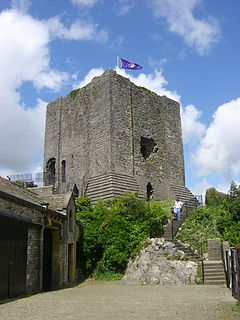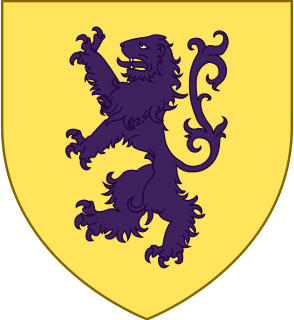
Pontefract is a historic market town in the Wakefield District of West Yorkshire, England, near the A1 and the M62 motorway. Historically part of the West Riding of Yorkshire, it is one of the five towns in the metropolitan borough of the City of Wakefield and had a population of 30,881 at the 2011 Census. Pontefract's motto is Post mortem patris pro filio, Latin for "After the death of the father, support the son", a reference to the English Civil War Royalist sympathies.

Thomas, Earl of Lancaster and Leicester was an English nobleman. A member of the House of Plantagenet, he was one of the leaders of the baronial opposition to his first cousin, King Edward II of England.

Earl of Lincoln is a title that has been created eight times in the Peerage of England, most recently in 1534. The title was borne by the Dukes of Newcastle-under-Lyne from 1768 to 1988, until the dukedom became extinct.

Pontefract cakes are a type of small, roughly circular black sweet measuring approximately 3/4" (2 cm) wide and 1/5" (4mm) thick, made of liquorice, originally manufactured in the Yorkshire town of Pontefract, England.

PontefractCastle is a castle ruin in the town of Pontefract, in West Yorkshire, England. King Richard II is thought to have died there. It was the site of a series of famous sieges during the 17th-century English Civil War.

de Lacy is the surname of an old Norman family which originated from Lassy, Calvados. The family took part in the Norman conquest of England and the later Norman invasion of Ireland. The name is first recorded for Hugh de Lacy (1020–1085). His sons, Walter and Ilbert, left Normandy and travelled to England with William the Conqueror. The awards of land by the Conqueror to the de Lacy sons led to two distinct branches of the family: the northern branch, centred on Blackburnshire and west Yorkshire was held by Ilbert's descendants; the southern branch of Marcher Lords, centred on Herefordshire and Shropshire, was held by Walter's descendants.

The barony of Halton, in Cheshire, England, comprised a succession of 15 barons who held under the overlordship of the County Palatine of Chester ruled by the Earl of Chester. It was not therefore an English feudal barony which was under full royal jurisdiction, which is the usual sense of the term, but a separate class of barony within a palatinate. After the Norman conquest, William the Conqueror created three earldoms to protect his border with Wales, namely Shrewsbury, Hereford and Chester. Hugh Lupus was appointed Earl of Chester and he appointed his cousin, Nigel of Cotentin, as the first baron of Halton. Halton was a village in Cheshire which is now part of the town of Runcorn. At its centre is a rocky prominence on which was built Halton Castle, the seat of the barons of Halton; the castle is now a ruin.

Clitheroe Castle is a ruined early medieval castle in Clitheroe in Lancashire, England. It was the caput of the Honour of Clitheroe, a vast estate stretching along the western side of the Pennines.

Henry de Lacy, Earl of Lincoln, Baron of Pontefract, Lord of Bowland, Baron of Halton and hereditary Constable of Chester, was an English nobleman and confidant of King Edward I. He served Edward in Wales, France, and Scotland, both as a soldier and a diplomat. Through his mother he was a great grandson of Amadeus IV, Count of Savoy. He is the addressee, or joint composer, of a poem by Walter of Bibbesworth about crusading, La pleinte par entre missire Henry de Lacy et sire Wauter de Bybelesworthe pur la croiserie en la terre seinte.

Roger de Lacy (1170–1211), Baron of Pontefract, Lord of Bowland, Lord of Blackburnshire, Baron of Halton, Constable of Chester, Sheriff of Yorkshire and Sheriff of Cumberland, also known as Roger le Constable, was a notable Anglo-Norman soldier, crusader and baron.
Maud de Lacy was an English noblewoman, being the eldest child of John de Lacy, 2nd Earl of Lincoln, and the wife of Richard de Clare, 5th Earl of Hertford, 6th Earl of Gloucester.

The Honour of Clitheroe is an ancient grouping of manors and royal forests centred on Clitheroe Castle in Lancashire, England; an honour traditionally being the grant of a large landholding complex, not all of whose parts are contiguous. In the case of Clitheroe, this complex was loosely clustered around the ancient wapentake of Blackburnshire.
St Richard's Friary, also known as Pontefract Friary, was a Dominican friary in Pontefract, West Yorkshire, England. It was located near today's Pontefract General Infirmary, on the eastern edge of Friarwood Valley Gardens.
Alice de Lacy, suo jure Countess of Lincoln, suo jure 5th Countess of Salisbury was an English peeress.
Edmund de Lacy, Earl of Lincoln (c.1230–1258) was an important landholder in Northern England, with a strategic manor at Stanbury which was important for east–west communication, and as Lord of the Honour of Pontefract he possessed Pontefract Castle.

John de Lacy, 2nd Earl of Lincoln was hereditary Constable of Chester, 7th Baron of Pontefract, 8th Baron of Halton and 8th Lord of Bowland.

The Forest of Pendle is the name given to an area of hilly landscape to the east of Pendle Hill in eastern Lancashire, roughly defining the watershed between the River Ribble and its tributary the River Calder. The forest is not identical to the modern local government district of Pendle, which is larger. And in fact the modern version of the forest has come to contain areas to the north and east of Pendle Hill which are partly in the district of Ribble Valley.
The honour of Pontefract, also known as the feudal barony of Pontefract, was an English feudal barony. Its origins lie in the grant of a large, compact set of landholdings in Yorkshire, made between the Norman conquest of England in 1066 and the completion of the Domesday Survey in 1086. An expansive set of landholdings spanning sixty parishes and six wapentakes in Yorkshire, the honour was created primarily to serve a strategic, defensive function in a potentially hostile frontier zone. The first lord was Ilbert de Lacy, who built a castle at Pontefract which became the caput of the honour. Alongside the Yorkshire holdings, a smaller number of dispersed possessions elsewhere in England belonged to the honour.

The Constable of Chester was a mediaeval hereditary office appointed by the Earl of Chester, Count Palatine, within his princely quasi-autonomous County Palatine of Chester. The functions of the Constable are unclear, possibly they related to the custody of Chester Castle, as was the main function of most mediaeval constables, but Sanders (1960) says the office-holder was constable for the entire County Palatine.
Pontefract is an historic market town in West Yorkshire, England.